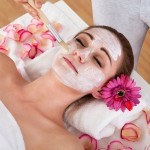 Chemical peels have become very common in the last few years, but what are they really?
Chemical peels have become very common in the last few years, but what are they really?
Chemical peels are designed to improve the texture of facial skin by damaging the skin in a controlled manner, thereby creating a ‘wound’. To do this, a solution is applied to the skin that dissolves the “glue” holding the top layer of dead, older skin cells together, causing them to slough and peel off. Once this is done, the new skin cells underneath are revealed, giving the appearance of an improved skin tone.
There are a variety of different peels available, for example: Alpha Hydroxy Acid peels (AHAs) and these include the use of citric acid, glycolic acid, lactic acid, etc., as well as Beta Hydroxy Acid peels and Retinoic Acid peels. Once thing you do need to bear in mind when having an AHA peel done is that it may cause mild stinging, mild skin irritation, skin redness and dryness.
At-home peel kits are available on the market however, chemical peels should always be done by a trained professional to avoid any unnecessary damage being done to the skin and to prevent you from accidentally burning your skin. These are acids after all!
While the odd chemical peel now and then (no more than once a month) may in fact be good for your skin, having these treatments done too frequently (or if they’re incorrectly applied) can lead to serious skin damage. Sunscreen should always be applied for a few days after a chemical peel or after using products containing AHAs, as the new skin cells are sensitive and sunburn can occur easily.
Frequent peels cause the facial skin to be thinned down too much, leaving the face looking and feeling raw, red, inflamed and very sensitive. Skin cells are naturally regenerated and replaced every month and if the body is not given sufficient time to do so between peels, layers of skin will be lost. On average during your Teens and early 20’s, skin cells regenerate every 21-28 days but as we begin to age, this slows down to every 30-40 days. Around the age of 50+, skin cell turnover can slow right down to between 1½ to 3 months!
 My first (and only) chemical peel was a Lactic Acid peel and to be honest, I wasn’t impressed. During the treatment my skin felt like it was on fire due the intense stinging and even once the solution was removed it still tingled uncomfortably for about 5 minutes before settling down. After the treatment, my face was red and blotchy for a few hours and the skin looked extremely shiny and was very sensitive for a few days.
My first (and only) chemical peel was a Lactic Acid peel and to be honest, I wasn’t impressed. During the treatment my skin felt like it was on fire due the intense stinging and even once the solution was removed it still tingled uncomfortably for about 5 minutes before settling down. After the treatment, my face was red and blotchy for a few hours and the skin looked extremely shiny and was very sensitive for a few days.
The results didn’t really look or feel any different to using a good exfoliator, except for the extreme shininess and sensitivity on the first two days. And then came the bad part. My skin broke out with more pimples than I’ve had in years! Apparently breakouts are normal after a peel. Personally, I was not impressed and won’t be going back for another peel. After paying all that money for “better looking skin”, I ended up looking like I had teenage acne for a week! Thanks, but no thanks. I think I’ll stick to my regular skincare routine and weekly at-home exfoliation followed by a face mask and topped off with a rich, nourishing night cream. I’ll be saving the money I’d spend on a chemical peel for something else!
If you’re not keen on a chemical peel, but want to try improve the appearance of your skin, try using an exfoliator containing AHAs on a weekly basis.


Leave a Reply
You must be logged in to post a comment.